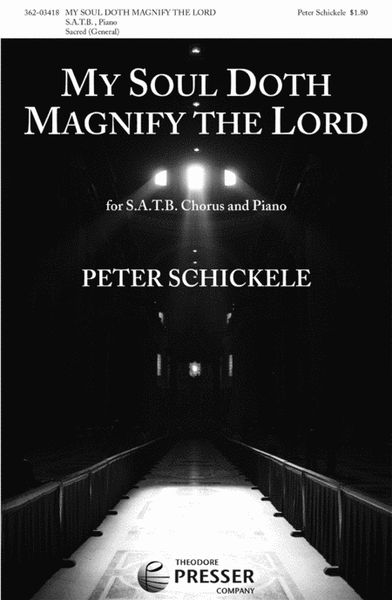My Soul Doth Magnify the Lord
-
Ships in 1 to 2 weeks
Details
Description
SKU: PR.362034180
Composed by Peter Schickele. Magnificat. World Premiere: Rockland Camerata, Rockland County NY. Performance Score. With Standard notation. Composed January 15 1998. 12 pages. Duration 4:30. Theodore Presser Company #362-03418. Published by Theodore Presser Company (PR.362034180).ISBN 9781598062496. UPC: 680160587391. 6.875 x 10.5 inches. English. Magnificat.
Commissioned by the composer’s college music instructor, William Reese, for his choir in Rockland County, New York, Schickele’s setting of the first part of the Magnificat text. It was premiered in April of 1998 by the Rockland Camerata. As most of Schickele’s choral works are secular, this is a rare and truly lovely contribution to the sacred choral library from a well-known composer. From Schickele’s notes: In the outer sections of the work the three musical entities (chorus, piano, and the strings) are given overlapping homophonic phrases much in the manner of Monteverdi’s and the Gabrielis’ antiphonal choir pieces in early 17th-century Venice, although, of course, the harmonic language is completely different. The middle sections feature lyrical vocal lines over repeated instrumental figures, leading to a climactic ending. String parts available on rental. Duration: 4’30.
For a while in the mid-1950’s, I was Swarthmore College’s first and only music major. This situation was due, I think, to the fact that the college had been founded by Quakers, and most Quakers felt that music was too sensuous to be trusted (and, let’s face it, they were right). When I arrived, the music department only had one professor, who also taught at Haverford; the orchestra was conducted by the astronomy prof, and the chorus by a Spanish prof, both nice gentlemen, but not of professional caliber. During my time, however, things began to look up, and one of the most colorful additions to the faculty was William Reese, who was brought in to conduct the orchestra. He was delightful, with his slight English accent, and he was a barrel of enthusiasm, but he could also be irascible, and not always rational. Once at a rehearsal, when one of the second violinists put his instrument down during the music, Reese stopped the orchestra, saying, “Why aren’t you playing? Why aren’t you playing?” “Sir, one of my strings broke,” replied the violinist, whereupon Reese fairly screamed, “WELL, I CAN’T HELP THAT!”When you got to know him, though, you found that he had a warm heart, and we became friendly and stayed in occasional touch. Many years later he conducted a choir in Rockland County, NY, and contacted me about writing a commissioned piece for the group, employing, in addition to the chorus, piano and strings. I chose the beginning of the Magnificat text, in English; it was completed on January 15, 1998, and premiered by the Rockland Camerata on April 19, 1998.In the outer sections of the work the three musical entities (chorus, piano, and the strings) are given overlapping homophonic phrases much in the manner of Monteverdi’s and the Gabrielis’ antiphonal choir pieces in early 17th-century Venice, although, of course, the harmonic language is completely different. The middle sections feature lyrical vocal lines over repeated instrumental figures, leading to a climactic ending.Although I am quite a secular person by conventional standards, religious music and texts often speak forcefully to me, and the Magnificat is one of my favorites. I hope someday to make this work the first movement of a setting of the complete text; if and when that day comes, I’m probably going to throw in some timpani, too, all the more grandly to magnify the Lord.

 Share
Share